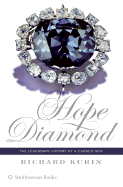 Do you believe in curses? Do you believe that a diamond can be cursed? Well, regardless of your opinion, you will be interested in this book, The Hope Diamond: The Legendary History of a Cursed Gem by Richard Kurin, which reads like part mystery, part historical narrative. This book details the journey of a large blue diamond from a mine in India to the Smithsonian Institution in Washington DC.
Do you believe in curses? Do you believe that a diamond can be cursed? Well, regardless of your opinion, you will be interested in this book, The Hope Diamond: The Legendary History of a Cursed Gem by Richard Kurin, which reads like part mystery, part historical narrative. This book details the journey of a large blue diamond from a mine in India to the Smithsonian Institution in Washington DC.
The Hope Diamond's story begins when the French adventurer and gem dealer, Jean-Baptiste Tavernier, purchased a crudely-cut 112-carat blue diamond in India. Or was this celebrated diamond actually stolen from the eye of a Hindu statue?
After he returned to France with the diamond, Tavernier sold it to King Louis XIV of France in 1668. Later, in 1749, King Louis XV had the stone recut and reset into the Order of the Golden Fleece, a piece of ceremonial jewelry. But in 1791, after Louis XVI and and his consort, Marie Antoinette, tried unsuccessfully to escape the country, the new government confiscated all the jewels of the French Royal Treasury. But in September of 1792, the crown jewels were looted, the French Blue, as it was known, disappeared. What happened to it?
According to the author, it is possible that the stone resurfaced briefly in 1812 when John Francillion described a deep blue diamond weighing 177 grains (44 carats) that was in the possession of London diamond merchant, Daniel Eliason. But this diamond disappeared shortly afterwards. The next historical mention of a large blue diamond is the 1839 entry in the catalogue of the famous gem collector, Henry Philip Hope, for whom the diamond is now named. Unfortunately, Hope never revealed where he acquired the diamond nor how much he paid for it. Was this actually the lost French Blue diamond?
Following Hope's death in 1839, and much litigation, the stone was sold to help pay off debts. Eventually, the Hope Diamond was purchased by Harry Winston Inc., of New York City. By this time, the diamond had been widely reported to be cursed because it had supposedly been stolen from the eye of a Hindu statue. According to the legend, the diamond caused bad luck, ill health or even death to those who possessed it, or even touched it.
Despite its presumed curse, the Hope diamond toured the world for the next ten years as part of many exhibits and charitable events. Then in November 1958, the diamond was donated to the Smithsonian Institution, and almost immediately became the main attraction, although it also generated a lot of controversy because of its legendary curse. But was the diamond actually cursed? Since none of the previous owners of the blue diamond ever considered it to be cursed, where did the legend of the curse come from?
This book does a good job reporting both fact and fiction by following the path of this stunning and celebrated blue diamond as it passed through the hands of famous kings and the richest people in the world to finally end up as part of the collection at the Smithsonian Museum. The author also describes the history of the diamond trade and how precious stones are classified, and identifies where and when the myth originated of the Hope diamond's legendary curse.
Richard Kurin is the director of the Smithsonian Center for Folklife and Cultural Heritage where he oversees the Smithsonian Folklife Festival, Smithsonian Folkways Recordings, and other cultural heritage programs. A former Fulbright fellow with a Ph.D. from the University of Chicago, he is the author of Reflections of a Culture Broker: A View from the Smithsonian. Dr. Kurin has been awarded the Smithsonian Secretary's Gold Medal for Exceptional Service and the American Folklore Society's Botkin Prize for lifetime achievement.
.

I do not believe in curses but my kids thought it was funny that the day we went to see the Hope Diamond we got a parking ticket.
Mimi